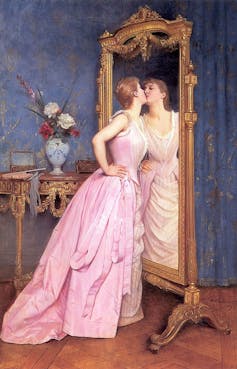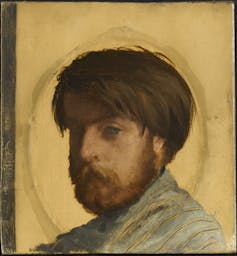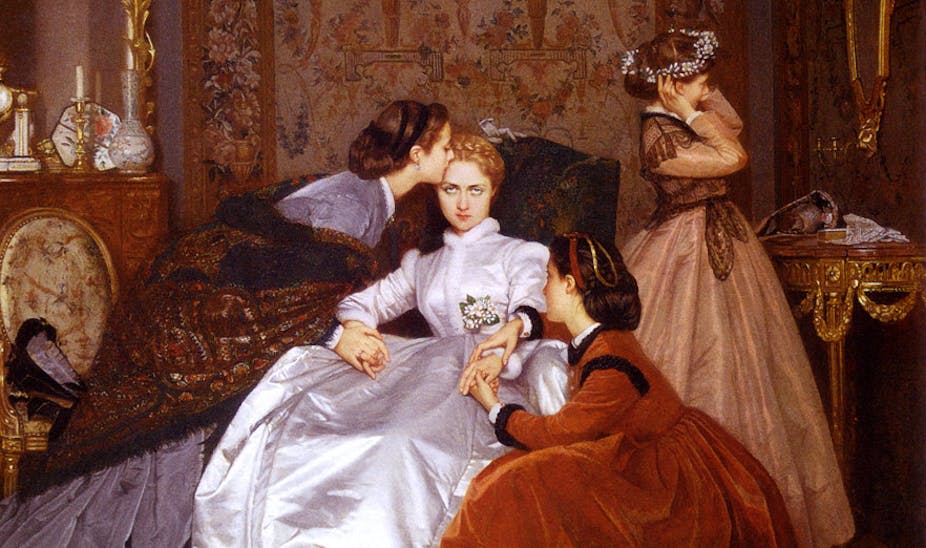You might have seen this painting making the rounds on TikTok. Maybe you’ve even made a video responding to it. A young woman in a Victorian wedding dress is staring down the viewer with disdain in her eyes.
Three women surround her, seemingly trying to placate her. Nonetheless, the direct and unrepentant gaze of the bride grips its viewer with the intensity of her stare. On TikTok, the painting is accompanied by thundering classical music, reminiscent of the climax of a battle – Verdi’s Requiem Dies Irae.
The woman’s gaze has been heralded as an iconic depiction of feminine rage. Women on Tiktok have taken to adding their own text to the painting to capture the feeling being depicted.
“You look so unapproachable,” says one, followed by: “And yet, here you are.” “It’s probably because men are intimidated by you,” posits another, followed by: “As they should be.”
Where did this unusual painting come from? The Hesitant Fiancée (also known as The Reluctant Bride) was painted in 1866 by French artist Auguste Toulmouche (1829-1890).

This article is part of Quarter Life, a series about issues affecting those of us in our twenties and thirties. From the challenges of beginning a career and taking care of our mental health, to the excitement of starting a family, adopting a pet or just making friends as an adult. The articles in this series explore the questions and bring answers as we navigate this turbulent period of life.
You may be interested in:
Why a social media detox may not be as good for you as you think – new research
How to know if your employer is serious about helping you find purpose in your work
Though not a household name today, Toulmouche rubbed shoulders with some of the most famous artists of all time.

He was married to Claude Monet’s cousin and was asked to mentor Monet when he first moved to Paris. He supported the aspiring artist by referring Monet to his own painting teacher, Charles Gleyre.
This move connected Monet to a wider community of emerging painters, such as Renoir, Sisley and Bazille, who became known as the impressionists – kickstarting one of the most influential art movements in history.
Toulmouche was a painter of the romantic school and he specialised in fashion painting (sometimes referred to as costume painting).
This style was incredibly popular in the opulent salons of 19th-century Paris. Fashion painting focuses on depicting lavish garments, furniture and rooms within upper-class homes.
Some of Toulmouche’s most famous paintings, The Love Letter, Vanity and The Reading Lesson, are typical of this style, portraying wealthy Parisian housewives.
The Hesitant Fiancée
The Hesitant Fiancée is a classic example of fashion painting. It relies on the clothing of the women to tell much of the story, while also showcasing exquisite styles, accessories and fabrics. However, this is where the similarities to Toulmouche’s other works end.
There is a high level of theatricality to the painting. By placing the women at the bottom of the view, Toulmouche is able to use rich furnishings to emphasise the height of the room, mimicking a stage.

The juxtaposition of the beautiful clothing, the ornate room and the other women staring at the bride (away from the viewer) draw the eye to the main subject, emphasising the gaze of the bride.
The Hesitant Fiancée marked a notable tone shift for Toulmouche, with the direct and unrepentant gaze of the bride directly addressing the viewer. She subverts socio-cultural expectations of the period by expressing her resistance to marriage.
The fourth wall break (in which the bride makes eye contact with the viewer) was not often used in this school, or by Toulmouche. Similarly, the bride’s negative emotions are a massive departure from other fashion paintings from the period.
This choice makes the painting stand out from its contemporaries, which primarily feature much more demure women.
Before this work, Toulmouche was known for exclusively painting “beautiful yet idle women”. A contemporary critic, Émile Zola, notably titled Toulmouche’s sitters “delicious dolls”, with another critic from the period saying the women in his paintings “have no brains”.
Toulmouche and the Fleabag stare
So why has this painting become popular again now? The reluctant bride’s unwavering gaze has been lauded for its accurate depiction of feminine rage, a concept historically difficult for male artists to capture.
In the past, female rage has often been portrayed as one of two extremes – silent, calm and internal, or external, with screaming and hysteria. This limiting dichotomy is misogynistic.
A modern contemporary to the Hesitant Fianceé can be seen in Phoebe Waller-Bridge’s Fleabag, the critically acclaimed TV series depicting a gutsy, honest female protagonist, who often breaks the fourth wall by staring directly at the viewer.
Her direct gaze (known online as the “Fleabag stare”) confronts the viewer with incredulity at what is considered the “acceptable” female experience and invites them to acknowledge her struggle.
The bride’s stare reaches out to the viewer in a Fleabag-esque way, asking you to consider the position she has found herself in. Her rage stands out against the softness of the woman’s world around her, challenging the viewer to place themselves in her shoes.
By participating in this trend, TikTok users are allowing their emotions to be reflected back to them through the bride’s defiant expression. By doing so, they are recontextualising the art into a more modern conversation, allowing the work to live on and remain relevant.
Much as young women may have felt seen by The Hesitant Fiancée when it was first shown in Paris in 1866, young women today see their own frustration and rage reflected in Toulmouche’s painting.
Art can help us understand what connects emotion and experience. And if the present-day popularity of this bride’s stare can tell us anything, it’s that female rage burns as fiercely as ever.

Looking for something good? Cut through the noise with a carefully curated selection of the latest releases, live events and exhibitions, straight to your inbox every fortnight, on Fridays. Sign up here.

